Process and Modes

Dr. Digvijay Singh
Director, Noble Eye Care
Gurugram
Sterilization is a process that destroys or eliminates all forms of microbial life including spores. It is carried out by physical or chemical methods. There are two types of sterilization: High 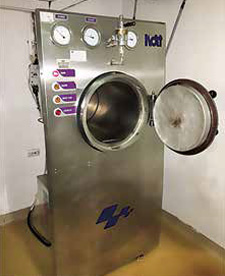 temperature and low temperature. Most medical and surgical devices used in healthcare are made of heat stable materials and can undergo heat (steam) sterilization. For less heat stable materials, ethylene oxide gas has been used for sterilization. Newer methods and agents for low-temperature sterilization (e.g., hydrogen peroxide gas plasma, per-acetic acid immersion, ozone) are gaining popularity in the past few decades. “Sterile” is measured as a probability of sterility referred to as the sterility assurance level (SAL) of the product and this is defined as the probability of a single viable microorganism occurring on a product after sterilization, expressed a IO.
temperature and low temperature. Most medical and surgical devices used in healthcare are made of heat stable materials and can undergo heat (steam) sterilization. For less heat stable materials, ethylene oxide gas has been used for sterilization. Newer methods and agents for low-temperature sterilization (e.g., hydrogen peroxide gas plasma, per-acetic acid immersion, ozone) are gaining popularity in the past few decades. “Sterile” is measured as a probability of sterility referred to as the sterility assurance level (SAL) of the product and this is defined as the probability of a single viable microorganism occurring on a product after sterilization, expressed a IO.
High Temperature Sterilization
Steam or Moist Heat sterilization
Moist heat sterilization in the form of saturated steam under pressure is the most dependable and widely used technique. It is nontoxic, inexpensive, rapidly microbicidal, sporicidal, and suitable for most materials. The basic principle is to expose each item to direct steam contact at the required temperature [121°C (250°F) or 134°C (275°F)] and pressure for the specified time.
The two basic types of steam sterilizers (autoclaves) are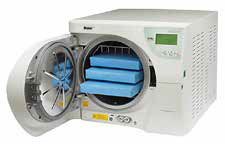 the gravity displacement autoclave and the highspeed pre-vacuum sterilizer. In the gravity displacement autoclave, steam is admitted at the top and/or the sides of the sterilizing chamber and forces air out the bottom of the chamber through a drain vent. This type of autoclaving is useful for laboratory media, water, pharmaceutical products, regulated medical waste, and nonporous articles. Since air may not be completely removed from porous items, this method is not preferred for sterilizing them or will require a very prolonged time.
the gravity displacement autoclave and the highspeed pre-vacuum sterilizer. In the gravity displacement autoclave, steam is admitted at the top and/or the sides of the sterilizing chamber and forces air out the bottom of the chamber through a drain vent. This type of autoclaving is useful for laboratory media, water, pharmaceutical products, regulated medical waste, and nonporous articles. Since air may not be completely removed from porous items, this method is not preferred for sterilizing them or will require a very prolonged time.
The high-speed pre-vacuum sterilizers are additionally fitted with a vacuum pump (or ejector) to ensure complete air removal from the sterilizing chamber and load before the steam is admitted. The advantage of using a vacuum pump is that there is nearly instantaneous steam penetration even into porous loads. The Bowie-Dick test is used to detect air le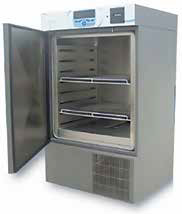 aks and inadequate air removal and consists of folded 100% cotton surgical towels or commercially available sheets/disposable test packs that are placed in various locations within the autoclave. Sterilizer vacuum performance is acceptable if the sheet inside the test pack shows a uniform color change as any entrapped air will cause a spot to appear.
aks and inadequate air removal and consists of folded 100% cotton surgical towels or commercially available sheets/disposable test packs that are placed in various locations within the autoclave. Sterilizer vacuum performance is acceptable if the sheet inside the test pack shows a uniform color change as any entrapped air will cause a spot to appear.
Certain autoclaves use a steam flush-pressure pulsing process, which removes air rapidly by repeatedly alternating a steam flush and a pressure pulse above atmospheric pressure without the use of vacuum. Since steam in the sterilizer chamber is always above atmospheric pressure, air leaks do not impact the sterilizing process. Typical sterilization temperatures and times are 132°C to 135°C with 3 to 4 minutes exposure time for porous loads and instruments.
Flash Sterilization
Flash sterilization is a modification of conventional steam sterilization in which the instrument is placed in an open tray or a specially designed, covered, rigid container to allow for rapid penetration of steam. While this is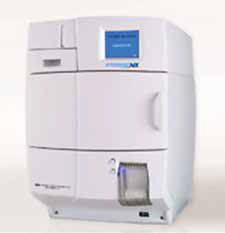 a quick process, it has certain drawbacks namely lack of timely biological monitoring indicators, absence of protective packaging following sterilization, higher chance of recontamination of processed items. Sterilization cycle parameters (i.e., time, temperature, steam quality) are minimal too. The instruments need to be air cooled or water cooled after the process. Its role should be limited to processing cleaned patient-care items that cannot be packaged, sterilized, and stored before use and when there is insufficient time to sterilize an item by the preferred package method. Flash sterilization should not be used for reasons of convenience. It is not recommended for most implantable devices.
a quick process, it has certain drawbacks namely lack of timely biological monitoring indicators, absence of protective packaging following sterilization, higher chance of recontamination of processed items. Sterilization cycle parameters (i.e., time, temperature, steam quality) are minimal too. The instruments need to be air cooled or water cooled after the process. Its role should be limited to processing cleaned patient-care items that cannot be packaged, sterilized, and stored before use and when there is insufficient time to sterilize an item by the preferred package method. Flash sterilization should not be used for reasons of convenience. It is not recommended for most implantable devices.
Low Temperature Sterilization
Ethylene Oxide Gas Sterilization
Ethylene oxide (EO) is one of the commonest low-temperature sterilant in use. Two types of EO sterilizers are available: mixed gas and 100% EO. Previously EO was combined with a Chloroflourocarbon (CFC) as a stabilizing agent, but environmental factors made this unpopular and unacceptable. EO works as an effective alkylating agent and affects the metabolism of microbes. The higher the concentration, the faster 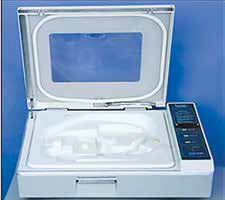 microbial inacrivation takes place. For effectively sterilizing, EO requires moisture for effective sterilization. Relative humidity levels in the chamber are generally kept between 40 to 80%. Moisture also facilitates the transfer of EO through films like nylon and cellophane. While EO is for low temperature sterilization, increasing temperature increases its sterilization effectiveness. For every 10°C rise in temperature the permeability of EO increases and sterilization rate doubles. Generally temperatures are kept between 37°C to 60°C and exposure period ranges between 1 to 6 hours. Sterilized objects/instruments adsorb EO and aeration is the process that removes this residual EO. Mechanical aeration is recommended at 55°C for 12 hours or at 37°C for 24 hours. In the absence of mechanical aerator, sterile material should be kept in a dedicated, enclosed area with minimum traffic and good ventilation for at least 7 days before use. Since EO can be used for prepackaged items, they have a good shelf life post sterilization. EO is non-corrosive to metal instruments and penetrates lumens efficiently. However the process is more complex than a steam sterilization and requires a longer cycle time of 12 – 16 hours. EO is toxic, flammable, carcinogenic and a reproductive hazard. Linen is not a recommended wrapper for this method. Use of EO requires monitoring of the enivornment to ensure that humans are not exposed to more than 1 ppm as an 8-hour time weighted average. Good ventilation and proper practices are needed to ensure safety.
microbial inacrivation takes place. For effectively sterilizing, EO requires moisture for effective sterilization. Relative humidity levels in the chamber are generally kept between 40 to 80%. Moisture also facilitates the transfer of EO through films like nylon and cellophane. While EO is for low temperature sterilization, increasing temperature increases its sterilization effectiveness. For every 10°C rise in temperature the permeability of EO increases and sterilization rate doubles. Generally temperatures are kept between 37°C to 60°C and exposure period ranges between 1 to 6 hours. Sterilized objects/instruments adsorb EO and aeration is the process that removes this residual EO. Mechanical aeration is recommended at 55°C for 12 hours or at 37°C for 24 hours. In the absence of mechanical aerator, sterile material should be kept in a dedicated, enclosed area with minimum traffic and good ventilation for at least 7 days before use. Since EO can be used for prepackaged items, they have a good shelf life post sterilization. EO is non-corrosive to metal instruments and penetrates lumens efficiently. However the process is more complex than a steam sterilization and requires a longer cycle time of 12 – 16 hours. EO is toxic, flammable, carcinogenic and a reproductive hazard. Linen is not a recommended wrapper for this method. Use of EO requires monitoring of the enivornment to ensure that humans are not exposed to more than 1 ppm as an 8-hour time weighted average. Good ventilation and proper practices are needed to ensure safety.
Hydrogen Peroxide Gas Plasma Sterilization
Gas plasmas are a state of matter generated in an enclosed chamber under deep vacuum using radio frequency or microwave energy to excite the gas molecules and produce charged particles and free radicals. 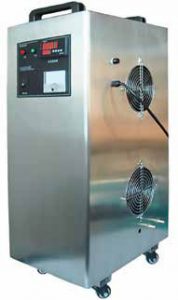 These free radicals interact with essential cell components (e.g. enzymes, nucleic acids) and disrupt metabolism. This form of sterilization is compatible with most medical devices and is effective in a short cycle of 36 to 70 minutes. Unlike EO, no aeration is required. No personnel monitoring is required. There are no toxic/chemical residues and the byproducts of sterilization are oxygen and water. However, items need to be wrapped in special non-woven polypropylene material. Paper and linen are unsuitable. Penetration in long lumens is limited.
These free radicals interact with essential cell components (e.g. enzymes, nucleic acids) and disrupt metabolism. This form of sterilization is compatible with most medical devices and is effective in a short cycle of 36 to 70 minutes. Unlike EO, no aeration is required. No personnel monitoring is required. There are no toxic/chemical residues and the byproducts of sterilization are oxygen and water. However, items need to be wrapped in special non-woven polypropylene material. Paper and linen are unsuitable. Penetration in long lumens is limited.
Peracetic Acid Sterilization
Peracetic acid (PPA) is a powerful germicidal agent which is highly corrosive and pungent. For sterilization applications, typically less than 0.5% concentrations in solution are needed. It is a liquid which manitanis its efficacy even in the presence of high levels of organic soil and kills micro-organisms in very few minutes even at concentrations less than 100 ppm. Since it relies on direct contact with all surfaces that require sterilization, penetration is not an issue. However any item which has surfaces which may escape a direct contact with the liquid cannot be sterilized in this manner. Items to be sterilized cannot be kept in packaging.
Packaging does not provide a penetration barrier, for the peracetic acid process, since it is a liquid process and does not employ wraps or pouches. As long as there is an open pathway for the liquid to contact all surfaces that require sterilization. The main benefit is a short cycle time of 30 minutes in a simple inexpensive machine. No personnel monitoring or special disposal is needed. However, it is irritating to skin and mucosa. It can’t be used for miscible products the sterilized items have no shelf life.
Ionizing radiation sterilization
Gamma rays emitted from Cobalt 60 are used for continuous processing by some processors for single use medical devices. However, this process is not suitable for terminal sterilisation at users premises.
Formaldehyde steam sterilization
This process generally involves placing articles to be sterilized in a chamber and then subjecting them to pulses of steam and formaldehyde vapor at sub-atmospheric pressure and relatively low temperatures such as 60 to 80°C.
Ozone sterilization
Ozone is an efficient, natural sterilization agent. It destroys any bacteria, viruses, cysts and pathogens in a very short duration when it comes into contact with air. It may be used as an environmental sterilant or for surgical instruments in the strength of 0.05 to 0.08 ppm. Special units are available for installation in OT’s.
Sterilization in Central Sterile Supply Department.
Monitoring of sterilization process.
The sterilization procedure should be monitored routinely by using a combination of mechanical, chemical, and biological indicators to evaluate the sterilizing conditions and indirectly the microbiologic status of the processed items.
Mechanical indicators:
The mechanical monitors for steam sterilization include the daily assessment of cycle time, temperature and pressure and documenting the same. For EO too mechanical monitors include time, temperature, and pressure records. Unfortunately Generally, gas concentration and humidity cannot be monitored in standard
EO sterilizers.
Chemical indicators:
Chemical indicators are convenient, inexpensive which indicate that the item has been expo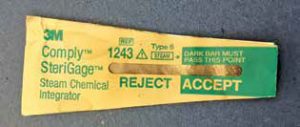 sed to the sterilization process. However they have a high false positivity and should be used in conjunction with biological indicators (consisting of resistant spores) Chemical indicators are affixed on the outside of each pack to show that the package has been processed through a sterilization cycle, but these indicators do not prove sterilization has been achieved. Ideally they should also be placed inside of each pack. Chemical indicators usually are either heat-or chemical-sensitive inks that change color when one or more sterilization parameters (e.g., steam-time, temperature, and/or saturated steam; EO – time, temperature, relative humidity and/or EO concentration) are present.
sed to the sterilization process. However they have a high false positivity and should be used in conjunction with biological indicators (consisting of resistant spores) Chemical indicators are affixed on the outside of each pack to show that the package has been processed through a sterilization cycle, but these indicators do not prove sterilization has been achieved. Ideally they should also be placed inside of each pack. Chemical indicators usually are either heat-or chemical-sensitive inks that change color when one or more sterilization parameters (e.g., steam-time, temperature, and/or saturated steam; EO – time, temperature, relative humidity and/or EO concentration) are present.
There are five classes of chemical indicators:
Class 1/Process Indicators:
These are intended for use with individual units, (e.g., packs, containers) to indicate that the unit has been directly exposed to the sterilization process and to distinguish between processed and unprocessed units. They are designed to react to one or more of the critical process variables. They are available in the form of indicator tapes, indicator labels, and load cards.
Class 2/Specific test Indicators:
These are intended for use in specific test procedures as defined in relevant sterilizer/sterilization standards such as Bowie-Dick type tests.
Class 3/Single Variable Indicators:
These are designed to react to one of the critical variables and is intended to indicate exposure to a sterilization process at a stated value (SV) of the chosen variable. Eg. Temperature tubes which contain a chemical pellet that melts at a specific temperature. They have limited usefulness.
Class 4/Multi-variable Indicators:
These are designed to react to two or more of the critical variables and indicate exposure to a sterilization cycle more holistically than class 3 indicators. Eg. Paper strips used for pack control.
Class 5/Integrating Indicators:
These are designed to react to all critical variables of the sterilization process and are the most comprehensive form of chemical indicators. They are used for pack control monitoring and specific monitoring for Implants etc. These indicators must have sterilization variables at 121°C/250°F, 135°C/276°F, and at least one more temperature in between and secondly at 121°C, exposure time must be greater than 16.5 minutes.
Class 6/Emulating Indicators:
These indicators are cycle verification indicators which are designed to react to all critical variables for specified sterilization cycles. Since these are specific for each cycle, a different Class 6 Emulating Indicator will be needed for each sterilization cycle time and temperature. The response of a Class 6 Emulating Indicator does not necessarily correlate to a Biological Indicator so they cannot be used as an additional monitoring tool to release loads that do not contain implants. They are not yet recognized as a separate class.
Biological Indicators
Biological indicators are the closest to the ideal monitors of the sterilization process because they measure 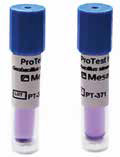 the
the
sterilization process directly by using the most resistant microorganism spores(i.e., Bacillus spores). Since the Bacillus spores used in biological indicators are more resistant and present in greater numbers than are the common microbial contaminants found on patient-care equipment, the demonstration that the biological indicator has been inactivated strongly implies that other potential pathogens in the load have been killed.
B. atrophaeus spores are used to monitor EO and dry heat, and G. stearothermophilus spores are used to monitor steam sterilization, hydrogen peroxide gas plasma, and liquid peracetic acid sterilizers. Steam and low temperature sterilizers (e.g., hydrogen peroxide gas plasma, per-acetic acid) should be monitored at least weekly. If multiple loads are run daily, then daily monitoring should be done. Each load should be monitored if it contains implantable objects. If feasible, implantable items should not be used until the results of spore tests are known to be negative.
Newer biological indicators are self-contained in plastic vials containing a spore-coated paper strip and a growth media in a crushable glass ampule. This indicator has a maximum incubation of 48 hours but significant failures can be detected in ≤ 24 hours. Another newer rapidreadout biological indicator that detects the presence of enzymes of G. stearothermophilus by reading a fluorescent product produced by the enzymatic  breakdown of a nonfluorescent substrate is available and parallels the sensitivity of conventional sterilization-specific biological indicators. Likewise, a new rapid-readout EO biological indicator has been designed for rapid and reliable monitoring of EO sterilization processes. This detects the presence of B. atrophaeus by detecting a fluorescent signal indicating the activity of an enzyme present within the organism. The fluorescence indicates the presence of an active spore-associated enzyme and a sterilization process failure. It also detects acid metabolites produced during growth of the B. atrophaeus spore. The enzyme is relatively EO resistant and is inactivated at a slightly longer exposure time than the spore, thereby making it a foolproof indicator. Biological indicators specifically designed for monitoring flash sterilization are also available.
breakdown of a nonfluorescent substrate is available and parallels the sensitivity of conventional sterilization-specific biological indicators. Likewise, a new rapid-readout EO biological indicator has been designed for rapid and reliable monitoring of EO sterilization processes. This detects the presence of B. atrophaeus by detecting a fluorescent signal indicating the activity of an enzyme present within the organism. The fluorescence indicates the presence of an active spore-associated enzyme and a sterilization process failure. It also detects acid metabolites produced during growth of the B. atrophaeus spore. The enzyme is relatively EO resistant and is inactivated at a slightly longer exposure time than the spore, thereby making it a foolproof indicator. Biological indicators specifically designed for monitoring flash sterilization are also available.